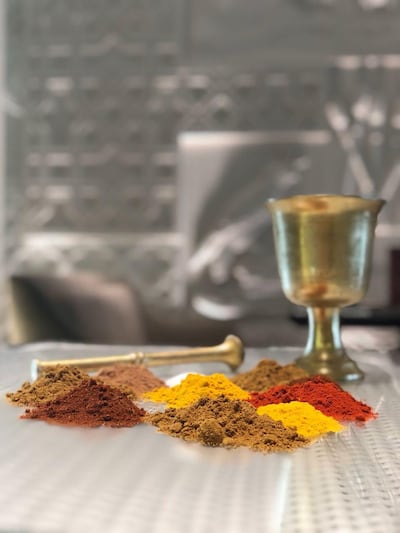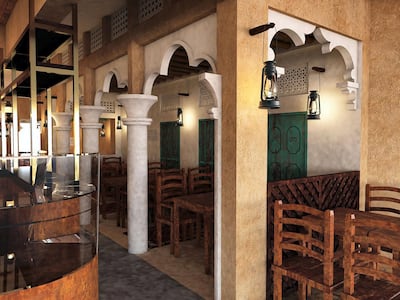Emirati cuisine is an edible testament to the history of the region. Much like the society of the country today, modern dishes of the UAE draw influence from those who have come here, yet local basics were borne out of necessity and remain the cornerstones of the cuisine.
What is Emirati food?
The origins of Emirati cuisine come from the Bedouins who roamed the country. With a focus on meat from goats and lambs, as well as fish caught from the Arabian Gulf – notably kingfish and grouper – the food staples are based on what was available at the time. Even chicken is a relatively new addition, becoming more available after the oil boom of the 1950s, with indigenous birds such as the Houbara bustard more common prior to that.
While today there is a growing use of camel meat, with camel burgers appearing in restaurants around the country, it was not an especially common meat to consume in the past. Camel would be occasionally served, in the case of high-profile events such as a VIP wedding, but typically the camel served as a main mode of transport rather than a source of food. Plus, camel’s milk was an important part of the diet.
For centuries, the UAE has been a place for traders in the region to meet and, as such, there has been an influence on Emirati food from those visiting, especially from Iran and India. Spices such as cardamom, saffron and cumin feature in myriad dishes and have been bought and sold in local ports for centuries. But how those spices are incorporated in meals is a key element that defines Emirati cooking.
Musabbeh Al Kaabi, executive chef at Jumeirah Zabeel Saray, has a clear idea about what makes Emirati cuisine distinct from others in the region. “The main difference is the use of spices and how they are infused into our dishes,” he says. “Every family has their own unique favourite spice combination, so we roast the ground spices up to their preferred mix and then blend them for added flavour.”
Along with that blend of home-mixed ground spices, Al Kaabi picks out dry lemon and ghee as ingredients that define local cooking.
Popular Emirati dishes
Popular Emirati dishes include harees (wheat and veal slow cooked and mashed with Arabic-spiced ghee); luqaimat (deep-fried dough balls dipped in date syrup); chebab (yeasted pancakes flavoured with saffron and cardamom); balaleet (vermicelli cooked in sugar, saffron and cardamom topped with an omelette); and thereed (slow-cooked stew made of chicken, lamb or goat and roasted vegetables).
To this list, Al Kaabi adds jasheed with white rice and local ghee; kingfish tahtah; and aish wa laham, which is essentially lamb cooked in a traditional way”.
His favourite, and perhaps the local dish you’re most likely to encounter, is chicken or seafood machboos, a dish with rice and spiced meat, often compared to a biryani.
“When I was growing up, I used to spend hours watching my mum cook for us, which inspired me. I learnt so many tips from her,” he says. “I’d invite friends and prepare all the dishes, mainly chicken machboos, which I had learnt from her, and decided that this was something that I wanted to pursue as a career.”
The concept of fowala
When it comes to how Emirati cuisine compares to those of other countries in the Gulf, Faisal Naser, chef and owner of Lento in Abu Dhabi, says there are more similarities than differences, but adds: “One eating habit that defines the UAE is called fowala, which is not a dish, but a way of setting up a meal with people sitting around it.
"Fowala consists of mainly fresh fruits, halwa, aseedah, which is made of flour date sugar and ghee, chebab and khameer bread. There’s a special fowala for occasions such Eid and weddings.”
The cuisine is modernising and evolving with access to more ingredients and different styles, but Naser believes preserving the traditions of the past is important. “I’d love to see all Emirati chefs working together to make a database for authentic Emirati recipes, techniques and ingredients, and become a reference for generations to come.
“More Emiratis are entering the F&B industry and developing an interest in becoming chefs, as well as social media encouraging many others to blog recipes and dig deep into this culinary world,” he adds. “We are also starting to see more Emirati-cuisine restaurants emerging, which is something we can be happy about.”
Here are five to try.
Emirati restaurants to try
Al Fanar: With branches all over the country (and one in London, too), Al Fanar not only offers an authentic taste of Emirati cuisine, but the decor also recreates the home of a merchant in the 1960s and makes for a sensory dining experience.
Al Mashowa: There are outlets of this local restaurant at City Walk and Riverland in Dubai, and they focus on the seafood element of Emirati cuisine, but with more than 70 dishes on the menu, all of the classics of local dining are also covered.
Logma: This Box Park restaurant in Dubai offers a casual, modern update of local dining, focusing on breakfast. Its standout dishes are the Logma Benedict – an Emirati take on the classic – and a traditional breakfast featuring breads, cream cheese and date syrup. There's also a branch in The Dubai Mall.
Mezlai: This Emirates Palace restaurant in Abu Dhabi takes Emirati cuisine to the higher end of the dining experience. In a setting inspired by a Bedouin tent, local dishes featuring rice, fish, lamb and goat are given the five-star treatment.
Mitts and Trays: Run by Amna Al Hashemi, the UAE's first female chef to open her own restaurant, this City Walk Dubai restaurant features Emirati twists on classic dishes, as well as breakfast dish balaleet – an omelette served over sweetened vermicelli – and meat and rice dish ouzi, served in a pastry pouch.













